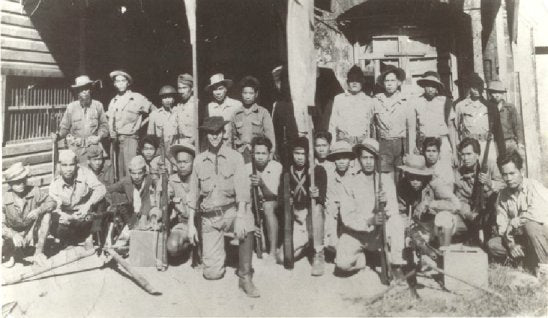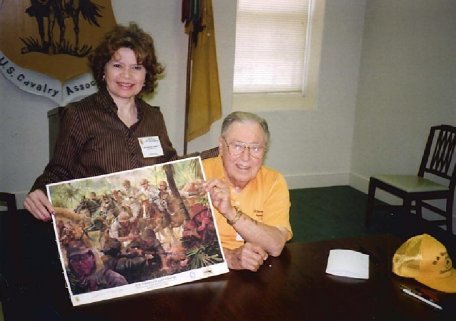The Last Horse Cavalry Charge
The Last Horse Cavalry Charge in U.S. History
Enemy fire had commenced. The point man was wounded. Twenty-four year old Lieutenant Edwin Price Ramsey glanced at his mounted troops and back toward the enemy scurrying among the buildings. He issued the command, “AS FORAGERS!” Without time to consider whether they were outnumbered, he ordered by hand and arm signals, “CHARGE!” This would be recorded as the last wartime horse cavalry charge in U.S. history. No, this wasn’t during the Indian Wars, Spanish-American War or World War I. The date was January 16, 1942. Stuck on the Philippines after the US surrender in 1942- and after leading the last U.S. horse cavalry charge in battle – Ed Ramsey refused to surrender. Instead, he escaped capture by the Japanese and joined the Filipino resistance. Rejecting the opportunity to escape, Ramsey withstood unimaginable fear, pain, and loss for three long years. Edwin Price Ramsey was born in Illinois, raised in Kansas, and graduated from the Oklahoma Military Academy. Commissioned a 2nd Lieutenant in the Cavalry Reserve in May of 1938, he entered active service in February of 1941 with the famous 11th Cavalry Regiment, at Campo, California. In June of 1941 he volunteered for service in the Philippines with the elite 26th Cavalry Regiment (Philippine Scouts). With Regular Army officers and Filipino soldiers, the regiment was considerably smaller than a normal stateside Cavalry regiment. It consisted of six line troops in two squadrons, with a total of 54 officers and 784 enlisted men. They were “probably as fine, if not the finest, regiment the U.S. Army had,” Ramsey said. “The horses were cross-breeds shipped in from the states, with a good number of stallions for improving the breed over time.”

In December 1941, when Japan attacked Pearl Harbor and then invaded the Philippines, the regiment was ordered north as part of the North Luzon Force to oppose the Japanese landings in Lingayan Gulf. Additional landings elsewhere forced the withdrawal of the outnumbered American and Filipino forces, whose retreat was covered by the 26th Cavalry into Bataan. January 15th, 1942, Troop E, as advance guard, was heading toward the village of Morong. The town sat strategically on the west coast of Bataan and the South China Sea, so the US Army intended to take Morong and build a defense line. G Troop platoon leader Lieutenant Ramsey and Filipino soldiers had just returned from reconnaissance duty and they were scheduled for some “R&R.” Since no one knew the territory better than Ramsey, he offered to assist. Ramsey was quoted as saying, “I did the one thing they tell you never to do in the Army–volunteer.” On the morning of the 16th, General Jonathan M. Wainwright, North Luzon Forces commander, had ordered Ramsey to take the advance guard into Morong. Captain Wheeler, the Troop E commander told the General that Ramsey volunteered to assist him with the assault. “Nonsense … Ramsey, move out!” Wainwright ordered. And history was made. Ramsey led three mounted squadrons into the jungle consisting of a 27-man advance guard of Philippine Scouts, the 26th Cavalry, and the 1st Regular Division of the Philippine Army. Encountering a Japanese infantry and artillery force at Morong, Ramsey ordered the charge that would become famous as the final horse Cavalry charge in history. After a bitter battle, E Troop emerged from the Bataan jungles disheveled and dog-tired. They were able to fend off the Japanese and hold the city of Morong, with only three casualties. Ramsey himself received a mortar wound, but fortunately it wasn’t enough to stop him. Ironically, the surviving horses of America’s last Cavalry charge weren’t so lucky. They were butchered to provide food to the starved Filipino-American fighters. Escaping after the surrender of Bataan, Lieutenant Ramsey formed the guerrilla forces in Central Luzon. Then came three years of agonizing guerrilla warfare, waged by courageous Americans and Filipinos on Luzon Island, fighting both the imperial Japanese Army and communist Huk guerrillas to prepare the way for the return of General Douglas MacArthur. He rose to command more than 40,000 guerrillas and led covert operations against the Japanese, who put the elusive American leader at the top of their death list. Many of Ramsey’s fellow resistance leaders, some of them officers he served with prior to the war, were captured, tortured, and beheaded. Informants were everywhere and every move was a risk. He narrowly escaped many close calls with the Kempa-tei, the Japanese secret police. Ramsey also sent critical intelligence information to General Douglas MacArthur in preparation for the liberation of the Philippines. For gallantry in action, General Jonathan Wainwright awarded Ramsey the Silver Star. He also received a Purple Heart and three Presidential Unit Citations for defense of the Philippines, Lingayen Gulf and Bataan. In Manila, General of the Army Douglas MacArthur personally pinned the Distinguished Service Cross on Ramsey for his three years of guerrilla warfare and promoted him to Lieutenant Colonel. A hero to the Filipino people, Ramsey was awarded that country’s Medal of Honor, the Philippine Distinguished Conduct Star, the Distinguished Service Star with Oak Leaf Cluster, the Gold Cross of Valor and the Wounded Personnel Medal. Edwin Ramsey’s saga is a true story of unwavering courage, selfless service, and dedication to duty. His exploits were instrumental in allowing MacArthur’s return and victory in the Pacific. He is an American hero and a credit to the United States Cavalry. For more information and great images, be sure to visit http://www.edwinpriceramsey.com/


Mr. Ramsey and wife Raqui, holding a print depicting Ramsey’s Cavalry charge. The retired Colonel autographed the print and presented it to the curator of Fort Riley’s U.S. Cavalry museum. The print was commissioned by the United States Army and was created by renowned artist John Solie. The United States Cavalry Association is offering these prints for sale. More information can be found here: http://www.uscavalry.org/USCA-LastChargePrint.pdf . . For the REAL story, look for this book: Lieutenant Ramsey’s War: From Horse Soldier to Guerrilla Commander, written by Mr. Ramsey and Stephen J. Rivele. Information reprinted with permission from Mike Dailing, webmaster of http://www.edwinpriceramsey.com/





